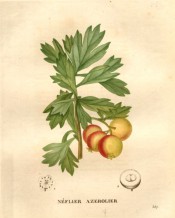Crataegus azarolus L.
Fully-hardy, thorny, deciduous shrub or small tree with fragrant white flowers with purple anthers in late spring, followed by edible, apple-flavoured, usually orange fruits. To 4.5m. [RHSD, Hortus, Hilliers’].
Horticultural & Botanical History
‘At present the Azarole is very scarce in this country, and we have never seen it in blossom but at Burchall’s nursery at Fulham, in May 1808.’ [ABR pl.579/1809]. Introduced to Britain in 1640. [JD]. Saint-Hilaire pl.357/1831. It has in the past been used in Arab traditional medicine.
History at Camden Park
Listed in the 1845, 1850 and 1857 catalogues [T.351/1845]. Probably introduced to evaluate its usefulness as a hedging species under colonial conditions.
Notes
Published Feb 05, 2010 - 01:34 PM | Last updated Aug 02, 2010 - 10:09 AM
| Family | Rosaceae |
|---|---|
| Category | |
| Region of origin | Southern Europe, North Africa, West Asia |
| Synonyms |
|
| Common Name | Azarole thorn, Cherry haw, Mediterranean medlar, Mosphilla |
| Name in the Camden Park Record |
Crataegus azarolus - Azarole Thorn |
| Confidence level | high |
